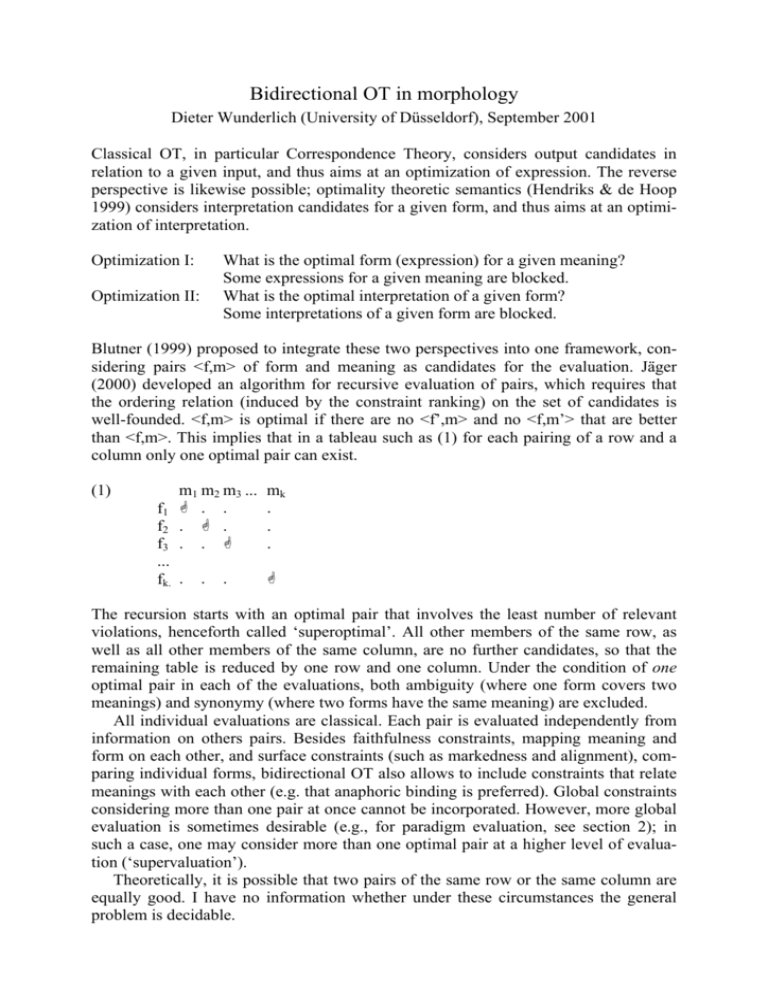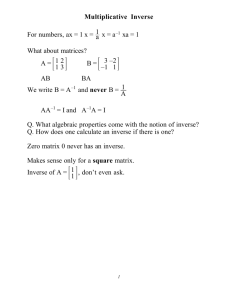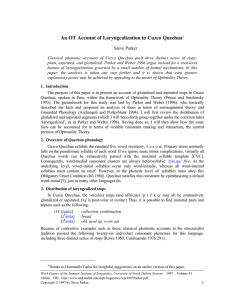Bidirectional OT in morphology
advertisement

Bidirectional OT in morphology
Dieter Wunderlich (University of Düsseldorf), September 2001
Classical OT, in particular Correspondence Theory, considers output candidates in
relation to a given input, and thus aims at an optimization of expression. The reverse
perspective is likewise possible; optimality theoretic semantics (Hendriks & de Hoop
1999) considers interpretation candidates for a given form, and thus aims at an optimization of interpretation.
Optimization I:
Optimization II:
What is the optimal form (expression) for a given meaning?
Some expressions for a given meaning are blocked.
What is the optimal interpretation of a given form?
Some interpretations of a given form are blocked.
Blutner (1999) proposed to integrate these two perspectives into one framework, considering pairs <f,m> of form and meaning as candidates for the evaluation. Jäger
(2000) developed an algorithm for recursive evaluation of pairs, which requires that
the ordering relation (induced by the constraint ranking) on the set of candidates is
well-founded. <f,m> is optimal if there are no <f’,m> and no <f,m’> that are better
than <f,m>. This implies that in a tableau such as (1) for each pairing of a row and a
column only one optimal pair can exist.
(1)
m1 m2 m3 ...
f1 * . .
f2 . * .
f3 . . *
...
fk. . . .
mk
.
.
.
*
The recursion starts with an optimal pair that involves the least number of relevant
violations, henceforth called ‘superoptimal’. All other members of the same row, as
well as all other members of the same column, are no further candidates, so that the
remaining table is reduced by one row and one column. Under the condition of one
optimal pair in each of the evaluations, both ambiguity (where one form covers two
meanings) and synonymy (where two forms have the same meaning) are excluded.
All individual evaluations are classical. Each pair is evaluated independently from
information on others pairs. Besides faithfulness constraints, mapping meaning and
form on each other, and surface constraints (such as markedness and alignment), comparing individual forms, bidirectional OT also allows to include constraints that relate
meanings with each other (e.g. that anaphoric binding is preferred). Global constraints
considering more than one pair at once cannot be incorporated. However, more global
evaluation is sometimes desirable (e.g., for paradigm evaluation, see section 2); in
such a case, one may consider more than one optimal pair at a higher level of evaluation (‘supervaluation’).
Theoretically, it is possible that two pairs of the same row or the same column are
equally good. I have no information whether under these circumstances the general
problem is decidable.
2
In the following, I first introduce a notation by which the challenging new spirit of
bidirectional OT can be illustrated for discussion. In section 2, I discuss a case of
paradigmatic syncretism, which varies cross-dialectally, and therefore calls for a more
global consideration. Section 3 deals with an asymmetry in the Quechua subject-object
paradigm; here, bidirectional OT sheds new light on some fundamental differences in
the several harmonic alignment accounts of morphological asymmetries discussed in
the literature. Section 4 illustrates how the notion of superoptimal pair can serve to
predict preferences between pairs (such as active-passive) that are not in the same
classical evaluation.
1. ‘Synonymengabel’
The workings of bidirectional OT can best be illustrated by the well-known ‘Synonymengabel’. It is exemplified by the English nouns pig vs. pork in sentences such as (3).
(2)
(3)
f1
m1
pig
‘(countable) animal of a certain kind: PIG’
f2
m2
pork
‘(non-countable) meat of PIG’
a. A pig/*pork ran on the street.
b. I don’t eat pig/pork.
In this case, there exist three pairs, exhibiting both ambiguity and synonymy. f1 is ambiguous; and f1, f2 are synonyms with respect to m2. For the sake of illustration, I will
use the format suggested by Dekker & van Rooy (2000), with the candidate pairs being the cells of a two-dimensional space. A fourth cell <f2,m1> is added here for completeness.
(4)
m1
f1 {
m2
{
f2 {
{
Let us assume that pork is more specific than pig in expressing ‘meat of PIG’, hence, it
is optimal in this respect. This is expressed in (5a) with an arrow indicating the preferred pair. All competing cells are, then, crossed out, as shown in (5b). The only remaining cell, itself not being dispreferred, is then optimal, too. Thus, under the given
assumptions, two optimal forms remain, so that the ‘Synonymengabel’ disappears.
(5)
a.
m1
f1 {
f2 {
m2
{
↓
n
b.
m1
f1 {
m2
⊗
f2 ⊗
*
c.
m1
f1 *
m2
f2
*
In addition, one might assume that the shortest form is preferred. Then the same result
obtains, although here, <f1,m1> is the superoptimal pair.
3
(6)
m1
f1 n
↑
f2 {
m2
{
↑↓
{
m1
f1 *
m2
f2
*
One could also assume that countable concepts are more natural than mass concepts.
Under this assumption there will be little chance that a mass noun such as pork appears, because all cells with m2 are dispreferred. However, together with the assumption of specificity (pig is more specific than pork in expressing animal beings, and
pork is more specific than pig in expressing meat), again, the same result obtains as
above.
(7)
m1 m2
f1 n ← {
↓
f2 { ← {
m1
f1 *
m2
f2
*
If we had a situation such as (8), no decision can be made; such a circular situation is
not well-founded.
(8)
m1
f1 { →
↑
f2 { ←
m2
{
↓
{
*!
In a situation such as (9), three pairs are equally good, so that the ‘Synonymengabel’
will remain.
(9)
m1 m2
f1 { ↔ {
↑
↑↓
f2 { → {
m1 m2
f1 *
*
f2
*
Finally, we can sketch the scenario under which only pig survives as an ambiguous
item.
(10)
m1 m2
f1 { ↔ {
↑
↑
f2 {
{
m1
f1 *
m2
*
f2
(10) also illustrates the situation of ambiguity to which we turn now.
2. Paradigmatic syncretism
Paradigmatic syncretism puts a problem for birectional OT if only one optimal pair
were allowed. The advantage of bidirectional OT to include also preferences among
meanings often cannot be taken because meaning preferences do not always exist in
morphological paradigms. The more interesting question in what sense paradigms may
suffer from syncretism can only be answered if one pursues evaluation on a higher
level.
4
In order to express plurality of either subject or object, Cajamarca Quechua has
only one plural morpheme, -llapa, while Cuzco Quechua has two, -ku and -chis (where
the latter only applies if a 2nd person precedes). They are distributed in the subdialects
of Cuzco in various ways. I only consider here suffix sequences for 2/1 settings (expressed by verb forms such as rika-wa-nki-chis ‘you (pl) see me’), where -wa signals
1st person object, and -nki 2nd person (Lakämper 2000).
(11)
m1: 2pl/1
m2: 2pl/1pl
m3: 2/1pl
a. Cajamarca
-wa-nki-llapa
-wa-nki-llapa
-wa-nki-llapa
b. Cuzco 2
-wa-nki-chis
-wa-nki-ku
-wa-nki-ku
c. Cuzco 3 & 4
-wa-nki-chis
-wa-nki-chis
-wa-nki-ku
d. Cuzco 1
-wa-nki-chis
-wa-nki-chis-ku
-wa-nki-ku
Note that all these dialects except Cuzco 1 are subject to a *PL-PL constraint that forbids more than one plural morpheme. As Lakämper has shown, in considering also the
other pl/pl settings of the input, it is the person higher on the hierarchy 1 > 2 > 3 that is
preferably marked for plural in Cuzco 2, while it is the more specific plural morpheme
(-chis) that is preferably applied in Cuzco 3, and even more complex conditions hold
in Cuzco 4.
(12)
m1
m2
m3
a. Cajamarca b. Cuzco 2
-llapa
chis ku
{
{ ←
{
↔{
{
{
c. Cuzco 3
chis ku
{ ←
{ ←
{
d. Cuzco 1
chis ku
{ ←
chis-ku
→{
{
Bidirectional OT, but as well the classical input-output account, can explain why there
is a 1:1 mapping between meaning and form in Cuzco 1. Bidirectional OT can also explain why the choice of -chis (which is more specific than -ku) blocks -ku in Cuzco 2.
In Cuzco 3, however, the first two pairs with -chis are equally better than -ku, so that
some syncretism remains in the two most optimal pairs. Here, the same result can easily be attained in the classical account, too. By contrast, no relevant competition of
forms arises in Cajamarca; -llapa-llapa is blocked here because of haplology.
None of these approaches accounts for the intuitive observation that Cajamarca
suffers most from syncretism, while Cuzco 1 is the best system in this regard, however, for the price of more morphemes and more articulated forms. The three-fold ambiguity in Cajamarca is reduced to a two-fold ambiguity in both Cuzco 2 and 3. Only
in a higher-level evaluation one can determine whether some of the systems are better
than others. Let us assume the constraints in (13).
(Syntagmatic economy)
(13) a. *PL-PL. At most one plural morpheme applies.
(Distinctivity)
b. NOSYNCR. Avoid syncretism in a paradigm.
c. MINMORPH. Minimize the number of morphemes. (Lexical economy)
With these constraints one can evaluate the given paradigmatic systems as follows.
One can see that each of the systems suffers from two violations of a lower-ranked
constraint, so that they all are equally imperfect.
5
(14) Paradigm evaluation
a. Cajamarca: *PL-PL, MINMORPH »
NOSYNCR
**
b. Cuzco 2/3: *PL-PL » MINMORPH, NOSYNCR
*
*
d. Cuzco 1:
NOSYNCR » MINMORPH, *PL-PL
*
*
3. The asymmetry of subject and object
My central point here is that bidirectional OT also sheds new light on the conceptual
nature of the hierarchies assumed by Aissen (1999) and Bresnan et al. (2001) on the
one hand, and by Stiebels (2000) and Wunderlich (2001) on the other. Aissen and
Bresnan claim that the ordering subject > object is basic, while Stiebels and Wunderlich argue for the opposite, more precisely, for the ordering [+hr] > [+lr] (where +hr is
an object feature, and +lr is a subject feature). I will claim here that these two perspectives can be integrated in bidirectional OT. The subject outranks the object semantically (and, possibly, also syntactically), while the object outranks the subject morphologically.
The example to be discussed concerns the Object-Subject-Constraint proposed in
Lakämper & Wunderlich (1998) in order to account for certain morphological asymmetries in Quechua. Obviously, this constraint, as it is originally stated, is not an elementary constraint.
(15)
Subject-Object Constraint. The object may be marked separately from the
subject only if it refers to a person that is higher on the hierarchy of person
than the person to which the subject refers. Hierarchy of person: 1 > 2 > 3.
The following table shows the singular forms of transitive verbs in Ayacucho
Quechua, together with some additional forms that are blocked. ‘O’ is short for the
accusative feature [+hr].
(16)
direct
inverse
m1: 1/3
m2: 2/3
m3: 3/3
m4 : 1/2
m5: 3/1
m6: 2/1
m7: 3/2
ni
1
*
nki
2
n
3
yki
1/2
wa-n
1O-3
wa-nki
1O-2
su-nki
O-2
su-ni
O-1
su-n
O-3
*
*
*
*
*
*
The first four settings (m1 to m4) are called ‘direct’, while the remaining settings (m5
to m7) are called ‘inverse’. Note that the direct settings are paired with single morphemes, while the inverse settings are paired with morpheme-combinations. This fact
gives us the key to a proper understanding of the distribution of forms.
Let us assume the person hierarchy in (17a). One way to implement this hierarchy
is the ordering of Max-Constraints shown in (17b). Besides being faithful to the person
6
features, it is also necessary to preserve the association between person and role,
which is expressed by the identity constraint in (17c).
(17) a. Person hierarchy: 1 > 2 > 3
b. Faithfulness:
Max(1) » Max(2) » Max(3)
Every person feature in the input is preserved in the output.
c. Identity: Id(pers)/role
For each role, the person feature associated with it in the output does not differ from that in the input.
Another way to implement the person hierarchy is harmonic alignment with the role
hierarchy. The salience hierarchy in (18a) states a difference between local person (1st
or 2nd) and nonlocal person (3rd). The role hierarchy in (18b) states that the feature
[+hr] ‘there is a higher role’ is more relevant than the feature [+lr] ‘there is a lower
role’ (see Stiebels 2000). By harmonic alignment of these two scales, the two contextualized markedness hierarchies in (19) are derived: the constraint (19a) is relevant
in Quechua because there it is in fact the case that 3rd person objects are never expressed, while (19b) is irrelevant because neither ergative nor dative exist in Quechua.
(18) a. Salience:
b. Role:
loc > 3
+hr > +lr
(19) a. *3/+hr »*3/+lr
b. *loc/+lr » *loc/+hr
(a semantic relation)
(a morphological relation)
(irrelevant for Quechua)
Stiebels (2000) notes the contextualized constraints reversely (*+hr/3). However, the
notation (a/x or x/a) does not play any role as long as the two scales to be aligned consist of just two values.
Like role, the salience hierarchy can also be expressed by means of relational features, with [+hs] for ‘there is an argument with higher salience’, see (20a). By means
of harmonic alignment, shown in (20c), then, the more general markedness hierarchy
in (20d) can be derived; note that (19a) is a specific instance of (20d). The contextualized features used in (20c,d) are identical with the definitions for ‘direct’ and ‘inverse’,
as given in (21) (Wunderlich 1996). Thus, (20d) correctly expresses that the appearance of a direct morpheme is more marked than the appearance of an inverse morpheme. [Just to make a small refinement: It would be more appropriate for Quechua to
define ‘direct’ as –hs/+lr, thereby including the setting 3/3 under ‘direct’, but this
doesn’t matter for the following.]
(20) a.
b.
c.
d.
Relational salience: −hs > +hs
Role: +hr > +lr
+hs/+lr > +hs/+hr
*(+hs/+hr) » *(+hs/+lr)
(21) a. direct: +hs/+hr
b. inverse: +hs/+lr
It is important to note that the role hierarchy +hr > +lr expresses what is more relevant
for the morphology, that is, roles with the feature [+hr] should preferably be marked
by morphology. This statement conflicts with a purely semantic hierarchy, saying that
logical subjects are better than logical objects for semantic reasons (e.g., being controller of an action, easier accessible in control structures, or possible antecedents). Simi-
7
larly, (20c) (based on the assumption of the role hierarchy +hr > +lr) conflicts with the
strong semantic intuition that direct transitive settings are more natural than inverse
transitive settings; but it is therefore that inverse settings should more easily be marked.
Thus, concerning the naturalness of settings, the hierarchy in (22b) should be assumed rather than (20c). Furthermore, one may state that (computationally) less complex forms are better than more complex forms, even if the less complex form is a
portmanteau morpheme (hence more compact) and the more complex form gets a
transparent reading, see (22a). By harmonic alignment, then, the markedness hierarchies in (23) can be derived.
(22) a. Complexity of forms: compact > transparent
b. Naturalness of settings: direct > inverse
(a morphological relation)
(a semantic relation)
(23) a. *compact/inverse » *compact/direct
b. *transparent/direct » *transparent/inverse
With these constraints, the actual Quechua forms given in (16) turn out to be optimal
under a classical OT analysis, without using the above-mentioned Object-Subject constraint. However, the classical OT does not allow us to take simultaneously two conflicting perspectives on the role of logical subjects and objects. The markedness constraint *3/[+hr] in (19a) is derived under the perspective of [+hr] > [+lr], regarding
formal features, while the constraints in (23) are derived under the perspective logical
subject > logical object, regarding meanings. It is the bidirectional OT account that
allows us to integrate these two perspectives.
(24)
m1
1/3
m2
3/1
f1 (unmarked) n ← {
↑
↓
f2 (marked)
{ ←{
←:
↑ :
↓ :
m1
1/3
m2
3/1
*
*
The direct setting is more natural than the inverse setting.
The unmarked form is preferred for a direct setting.
The marked form is preferred for an inverse setting.
It should be noted that Quechua lacks a passive, except the (non-productive) stative
passive formed with -raya (van de Kerke 1996: 19). Therefore, there is for each setting
only one optimal form. Bidirectional OT allows us to compare pairs of a setting and a
verb form as to which is preferred semantically. Thus, the asymmetry in the verb
forms reflects the distinction between direct and inverse settings, which are purely semantic notions here.
The same is true for a salience type language such as Arizona Tewa (Kroskrity
1985). Consider the examples in (25); here, only the more salient argument can be
marked on the verb. However, if the lower argument is marked on the verb, the higher
argument must receive an oblique suffix in the syntax.
8
(25) Arizona Tewa
a. he’i-n
sen-en dó-khwE@di
this-pl man-pl 1sg.AGT-hit
‘I hit these men’
b. he’i-n
sen-en-di
dí-khwE@di
this-pl man-pl-OBL 1sg.PAT-hit
‘These men hit me’
Here, again, one can compare the two forms with the two meanings to be expressed in
a bidirectional tableau, which is nearly identical to that in (23).
(26)
m1
1/3
m2
3/1
m1
1/3
n ←{
↑
↓
{ ←{
f1 (1.AGT)
f2 (1.PAT; OBL)
m2
3/1
*
*
4. The comparison of active and passive.
If passive morphology exists, there are two forms available for each setting, and these
forms also differ semantically in that the higher argument is existentially bound or not.
Therefore, the bidirectional OT scenario leaves us with four optimal forms.
(27)
f1 (active)
f2 (passive)
f3 (active)
f4 (passive)
m1
1/3
*
m2
(1)/3
m3
3/1
m4
(3)/1
*
*
*
It is not possible to compare these optimal pairs directly, so there is no way to block
one of them. However, bidirectional OT offers a way to assign preferences to the individual pairs for semantic-pragmatic reasons. Let us consider an English type language.
(28) a.
b.
c.
d.
1/3:
(1)/3:
3/1:
(3)/1:
I saw him.
He was seen (by me).
He saw me.
I was seen (by him).
The two following tableaus illustrate the comparison of active and passive for the two
settings; the active pair is superoptimal in the direct setting (29), while the passive pair
is superoptimal in the inverse setting (30). In each case, one could include more candidate forms, which, however, never would be better than the two forms chosen here.
(29)
m1
m2
λy3 λx1 λy3 ∃x1
f1 (1.NOM-3.ACC) n ←
↑
f2 (PASS; 3.NOM) { ←
{
↓
{
m1
m2
*
*
9
← : The more salient argument should not be bound existentially.
↑ : The NOM-ACC pattern is preferred for the transitive setting.
↓ : The PASS;NOM pattern is preferred for the intransitivized setting.
(30)
m1
m2
1
3
λy λx λy1 ∃x3
f1 (3.NOM-1.ACC) {
↑
f2 (PASS; 1.NOM) {
→{
↓
→n
m1
m2
*
*
← : The more salient argument should be associated with the higher theta role.
↑ : The NOM-ACC pattern is preferred for the transitive setting.
↓ : The PASS;NOM pattern is preferred for the intransitivized setting.
The same result yields if one compares the two settings in the active or the passive.
(31)
m1
m2
3
1
λy λx λy1 λx3
f1 (1.NOM-3.ACC) n ←
↑
f2 (3.NOM-1.ACC) { ←
(32)
{
↓
{
m1
m2
λy3 ∃x1 λy1 ∃x3
f1 (PASS; 3.NOM)
f2 (PASS; 1.NOM)
{
↑
{
→{
↓
→n
m1
m2
*
*
m1
m2
*
*
It is interesting to note that, under some circumstances, an inverse type language with
obviative marking also allows four different forms rather than two.
(33) Obviative in Plains Cree (Wolfart & Carroll 1981:30)
a. waapam-eew naapeew siisiip-a
‘The man sees the duck (obv)’
man
duck-OBV
see-DIRECT
b. waapam-ik
naapeew siisiip-a
‘The duck (obv) sees the man’
man
duck-OBV
see-INVERSE
c. waapam-eew naapeew-a siisiip
‘The duck sees the man (obv)’
man-OBV duck
see-DIRECT
d. waapam-ik
naapeew-a siisiip
‘The man (obv) sees the duck’
man-OBV duck
see-INVERSE
Here, we have the interaction of two semantic relations: sortal salience (in terms of the
human/non-human distinction), and discourse prominence, which overrides sortal salience in that the more prominent discourse argument triggers the choice between direct
and inverse marker. The more prominent argument in the discourse is underlined in the
semantic representations given in (34).
10
(34)
m1
m2
m3
m4
λynh λxh λyh λxnh λyh λxnh λynh λxh
f1 (DIR; duck-OBV)
f2 (INV; duck-OBV)
f3 (DIR; man-OBV)
f4 (INV; man-OBV)
n ⇐← {
↑
↓
{ ⇐← q
*{ ⇐→ *{
↑
↓
*{ ⇐→ *{
(33a)
*{ ⇐← *{
↑
↓
*{ ⇐← *{
o ⇐→ {
↑
↓
{ ⇐→ o
(33c)
(33b)
(33d)
←, → : The sortally more salient argument (human) should be the higher argument.
⇐ : The more prominent argument in the discourse should be the higher argument.
* : The less prominent argument in the discourse should be marked obviative
(violated in the respective items).
↑ : With the higher argument being more prominent, the direct marker is necessary.
↓ : With the lower argument being more prominent, the inverse marker is nec essary.
It is obvious from (34) that the pair identified as ‘n’ is superoptimal, while each of the
two pairs identified as ‘o’ violates one of the semantic constraints, and the pair identified as ‘q’ violates both semantic constraints and, therefore, is least preferred. In the
classical OT all four forms would come out as optimal for the respective reading.
However, bidirectional OT allows us to derive preferences between these pairs, according to whether they violate semantic constraints or not. Thus, the asymmetry of
arguments often is not reflected in the forms themselves, but nevertheless can be captured by semantic preferences.
Acknowledgments
I am grateful to Gerhard Jäger and Barbara Stiebels for enlighting discussions.
References
Aissen, Judith. 1999. Markedness and subject choice in Optimality Theory. Natural Language
and Linguistic Theory 17: 673-711.
Blutner, Reinhard (1999) Some aspects of optimality in natural language interpretation. In
Helen de Hoop & Henrieta de Swart (eds.) Papers on optimality theoretic semantics, 1-21.
Utrecht Institute of Linguistics OTS: Uil OTS Working Paper.
Bresnan, Joan, Shipra Dingare, and Christopher D. Manning. 2001. Soft constraints mirror
hard constraints: Voice and person in English and Lummi". To appear in Proceedings of
the LFG 01 Conference. Stanford: CSLI Publications.
Dekker, Joost & van Roy. 2000. Bi-directional optimality theory: An application of game
theory. Journal of Semantics 17: 217-242.
Hendriks, P. & Helen de Hoop. 1999. Optimal theoretic semantics. To appear in Linguistics
and Philosophy.
Jäger, Gerhard (2000) Some notes on the formal properties of bidirectional optimality theory.
In Reinhard Blutner & Gerhard Jäger (eds.) Studies in Optimality Theory, 41-63. Linguistics in Potsdam 8.
11
Kroskrity, Paul. 1985. A holistic understanding of Arizona Tewa passives. Language 61: 306328.
Lakämper, Renate. Plural- und Objektmarkierung in Quechua. Phil. Diss. University of
Düsseldorf.
Lakämper, Renate & Dieter Wunderlich. 1998. Person marking in Quechua – A constraintbased minimalist analysis. Lingua 105: 113-148.
Stiebels, Barbara. 2000. Linker inventories, linking splits and lexical economy. In Barbara
Stiebels & Dieter Wunderlich (eds.) Lexicon in Focus, 211-245. Berlin: Akademie Verlag.
van de Kerke, Simon C. 1996. Affix order and interpretation in Bolivian Quechua. Phil. Diss.
University of Amsterdam.
Wolfart, H. Christoph & Janet F. Carroll. 1981. Meet Cree. A guide to the language. Lincoln:
Univ. of Nebraska Press.
Wunderlich; Dieter (1996) A minimalist model of inflectional morphology. In Chris Wilder,
Hans-Martin Gärtner and Manfred Bierwisch (eds) The Role of Economy Principles in
Linguistic Theory, 267-298. Berlin: Akademie Verlag.
Wunderlich, Dieter. 2001. How gaps and substitutions can become optimal: the pronominal
affix paradigms of Yimas. Transactions of the Philological Society. In print.








